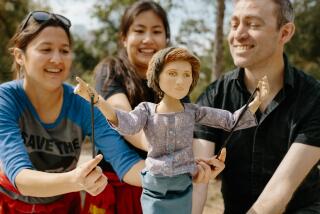STAGE REVIEW : Wayang Kulit: Shadow Puppets of the Javanese
- Share via
On a grassy slope between the Women’s Gym and Fowler Museum at UCLA, hundreds of people sprawl on blankets and cushions watching a stage not much larger than a big-screen TV. Hundreds more sit behind the performance space or stand on the balcony walkways overlooking the area.
In its only West Coast appearance, a company presenting traditional Javanese shadow puppet theater (Wayang Kulit) is ending its U.S. tour with this Saturday “Festival of Indonesia” event. Performances normally last until dawn, but this one runs three hours--not counting a lecture-demonstration early in the evening and the overture by the company gamelan (percussion orchestra).
Simultaneous translation headsets clarify the action and issues of “Wiratha Parwa,” an episode from the ancient Hindu epic “Mahabharata.” More than a mere announcer, R. Soeprapto offers his own artful approximation of the characters’ voices as he supplies the English equivalent of a partly improvised text full of topical references.
Besides jokes about the CIA, IRS, UCLA, “Candid Camera,” “Naked Hollywood” and the Gulf War, we hear such classic Americanisms as “Watch your mouth” and even “Make my day.” However, “Wiratha Parwa” also keeps returning to sober ethical questions, with several key scenes showing a subordinate who dares tell an unpleasant truth to his superior--and take the consequences.
The lecture-demonstration by company leader Pandam Guritno had focused on the philosophical implications of puppet iconography: how even the grotesque comic characters were designed to convey a profound world-view. Looking at the noble heroes of the epic--tiny and delicate, with impossibly elongated eyes, noses, limbs--we also encounter unattainable standards of beauty and refinement.
The flat, elaborately incised buffalo-hide rod-puppets are jointed only at the shoulders, elbows and wrists, so they can’t do very much. However revered master-puppeteer (dalang) Ki Anom Suroto gives each of them a distinctive movement style.
In battle scenes, he sometimes adds such virtuoso tricks as spinning or flipping the puppets. Moreover, with the shadow screen illuminated by an electric bulb (traditionally an oil lamp) directly over his head, Suroto can enlarge or distort any shadow by shifting the puppet’s distance from the screen or its angle.
From the front (the shadow side), Wayang Kulit provides a black-and-white spectacle featuring frequent transformations of shape and scale, as well as bravura combat scenes in which characters fling themselves at one another with incredible speed, ferocity and precision.
From the back (the dalang side), the colorfully painted puppets offer drama of another sort. Here you appreciate Suroto’s versatility: He operates all the puppets, speaks all the dialogue, cues the gamelan and produces some of the sound effects--with mallets held between his toes. He also sings, sometimes alone and sometimes with two women (Sri Retno Dewati and Suyatmi) or a chorus.
These songs usually represent contemplative digressions, but Suroto’s rich, expressive voice and the gamelan’s mellow musicianship make them seem the heart of this Wayang Kulit experience: a blend of vocal lyricism and bell-like overtones shimmering in the cool night air under a full moon.
More to Read
The biggest entertainment stories
Get our big stories about Hollywood, film, television, music, arts, culture and more right in your inbox as soon as they publish.
You may occasionally receive promotional content from the Los Angeles Times.










